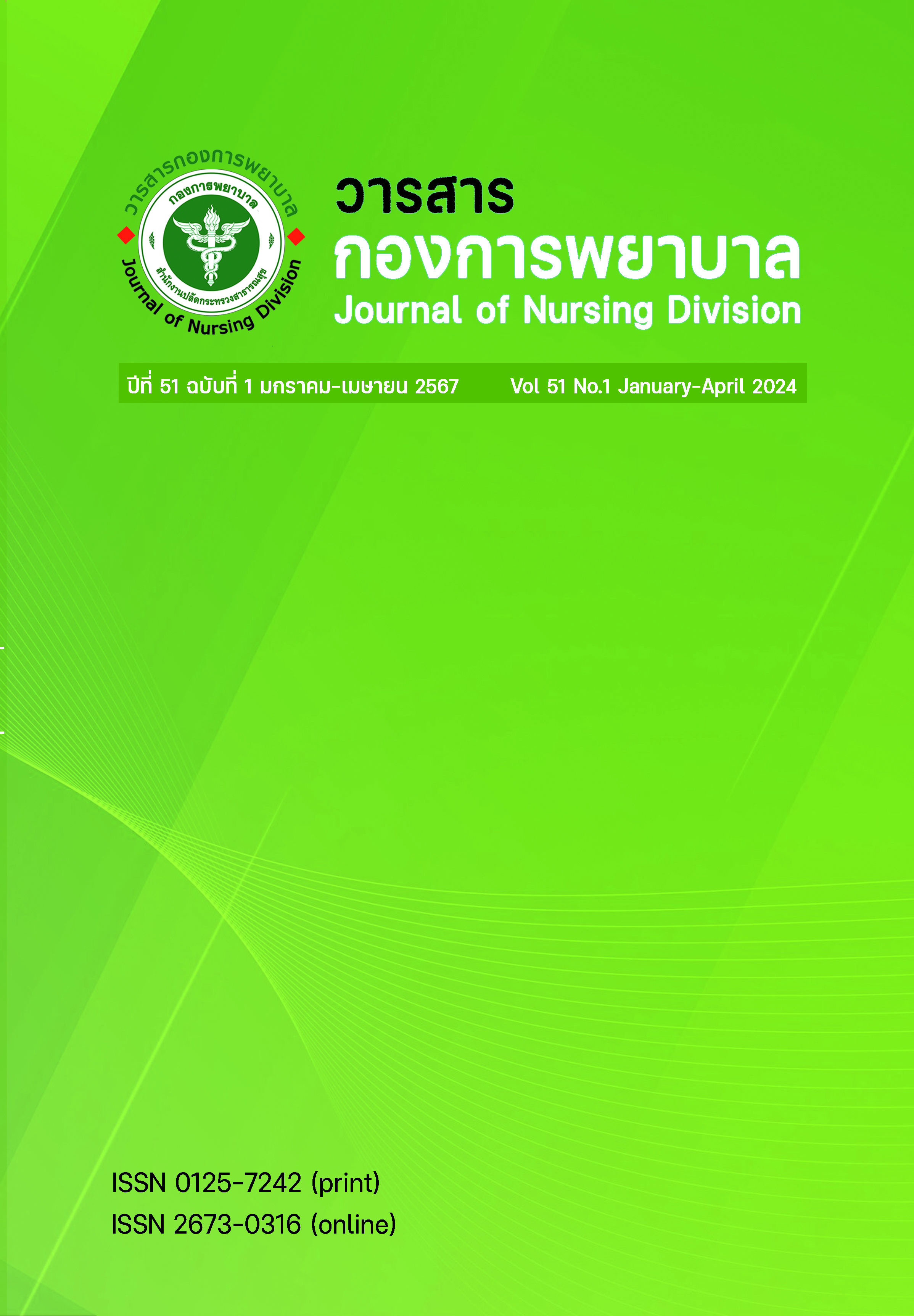อุบัติการณ์และปัจจัยที่เกี่ยวข้องกับการเกิดภาวะตกเลือดหลังคลอด ในโรงพยาบาลทั่วไป
Main Article Content
บทคัดย่อ
บทคัดย่อ
ภาวะตกเลือดหลังคลอด เป็นสาเหตุสำคัญของการเสียชีวิตของมารดาทั่วโลก การประเมินปัจจัยเสี่ยงร่วมกับการดูแลทางสูติศาสตร์อย่างเหมาะสมสามารถลดอุบัติการณ์ลงได้ การวิจัยนี้เป็นการศึกษาจากผลไปหาเหตุ (case-control study) มีวัตถุประสงค์เพื่อศึกษาอุบัติการณ์และปัจจัยที่สัมพันธ์กับการเกิดภาวะตกเลือดหลังคลอดภายใน 2 ชั่วโมงแรก ในโรงพยาบาลแม่สอด จังหวัดตาก กลุ่มตัวอย่าง คือ เวชระเบียนของผู้คลอด จำนวน 274 ราย แบ่งเป็นกลุ่มที่เกิดภาวะตกเลือดหลังคลอด จำนวน 72 ราย และไม่เกิดภาวะตกเลือดหลังคลอด จำนวน 202 ราย เก็บรวบรวมข้อมูลย้อนหลังจากเวชระเบียนและฐานข้อมูลของโรงพยาบาล เครื่องมือเก็บข้อมูล คือ แบบบันทึกข้อมูลทั่วไป ข้อมูลทางสูติศาสตร์ และข้อมูลผลลัพธ์ ตรวจสอบความตรงเชิงเนื้อหาได้เท่ากับ 0.92 วิเคราะห์ข้อมูลด้วยสถิติเชิงพรรณนา Chi-square test, Fischer’s exact test และ Multiple logistic regression
ผลการวิจัย: ผลการศึกษา case control ครั้งนี้ พบอุบัติการณ์ตกเลือดหลังคลอดภายใน 2 ชั่วโมงแรก จำนวน 72 คน (ร้อยละ 2.2) และไม่ตกเลือดหลังคลอดจำนวน 202 ราย (ร้อยละ 97.8) ปัจจัยที่ช่วยลดความเสี่ยงต่อภาวะตกเลือดหลังคลอด ภายใน 2 ชั่วโมงแรก คือ การฉีกขาดช่องทางคลอดระดับ First degree tear (OR 0.23; 95%CI 0.069-0.813, p = .022) ปัจจัยที่เพิ่มความเสี่ยงการตกเลือดหลังคลอดภายใน 2 ชั่วโมงแรก ได้แก่ การตั้งครรภ์ > 3 ครั้ง (OR 3.60; 95%CI 1.191-10.899, p = .023) และการฝากครรภ์ไม่ครบตามเกณฑ์ การฝากครรภ์คุณภาพ (OR 2.22; 95%CI 1.017-4.876, p = .045)
Article Details

อนุญาตภายใต้เงื่อนไข Creative Commons Attribution-NonCommercial-NoDerivatives 4.0 International License.
เอกสารอ้างอิง
References
Wonnee Keawkongthum. Effectiveness of using clinical nursing practice guideline for the prevention of early postpartum hemorrhage in Phatthalung Hospital. Health Science Journal of Thailand. 2020;2(3):37-47. Thai.
World Health Organization [WHO]. WHO recommendations for the prevention and treatment of postpartum hemorrhage: World Health Organization; 2012.
Huang CR, Xue B, Gao Y, Yue SW, Redding SR, Wang R, et al. Incidence and risk factors for postpartum hemorrhage after vaginal delivery: A systematic review and meta-analysis. J Obstet Gynaecol Res. 2023;49(7):1663-76.
Kramer M, Berg C, Abenhaim H, Dahhou M, Rouleau J, Mehrabadi A, et al. Incidence, risk factors, and temporal trends in severe postpartum hemorrhage. Obstetric Anesthesia Digest. 2014;34(4):201-2.
Say L, Chou D, Gemmill A, Tunçalp Ö, Moller A-B, Daniels J, et al. Global causes of maternal death: a WHO systematic analysis. The Lancet global health. 2014;2(6):e323-e33.
Higher Education Science Research and Innovation Policy Council. Unlocking Thailand into a developed country [cited 2024 Jan 19] Available from: https://www.nxpo.or.th/th/11772/2024. Thai.
Department of Health Ministry of Public Health. Annual Report: Maternal Death Surveillance and Response system in Thailand 2021: Bureau of Health Promotion, Department of Health, Ministry of Public Health; 2564. Thai.
Liu C-n, Yu F-b, Xu Y-z, Li J-s, Guan Z-h, Sun M-n, et al. Prevalence and risk factors of severe postpartum hemorrhage: a retrospective cohort study. BMC pregnancy and childbirth. 2021;21(1):1-8.
Kruathed Chaiyuth. Active versus Expectant Management of the Third Stage of Labor at Photharam Hospital. Journal of Health Science. 2006;15(5):753-59. Thai.
Natakorn I-Tuporn, Thitima Nutravong, Amornrat Ratanasiri, Kultalee Boonprasert, Supaporn Chatrchaiwiwatana, Tasanee Na Pikul. Risk Factors for Postpartum Hemorrhage via Vaginal Deliveries: Systematic Review and Meta-Analysis. Chiangrai Medical Journal. 2018;10(1):149-60. Thai.
Bestman PL, Nget M, Kolleh EM, Moeng E, Brhane T, Fang Jq, et al. A Comparative Analysis of Postpartum Hemorrhage Incidence and Influencing Factors between Nulliparous and Multiparous Women in Hunan Province, China: A Multicenter Retrospective Cohort Study. Preventive Medicine Reports. 2024:102580.
Amanuel T, Dache A, Dona A. Postpartum hemorrhage and its associated factors among women who gave birth at Yirgalem General Hospital, Sidama Regional State, Ethiopia. Health Services Research and Managerial Epidemiology. 2021;8:23333928211062777.
Thipawan Iamcharoen. Postpartum Hemorrhage: Significance of Nurse’s Roles in Prevention. Association Of Private Higher Education Institutions Of Thailand (APHEIT). 2017;6(2):146-57. Thai.
Dasa TT, Okunlola MA, Dessie Y. Effect of grand multiparity on adverse maternal outcomes: A prospective cohort study. Frontiers in Public Health. 2022;10:959633.
Mitta K, Tsakiridis I, Dagklis T, Grigoriadou R, Mamopoulos A, Athanasiadis A, et al. Incidence and Risk Factors for Postpartum Hemorrhage: A Case-Control Study in a Tertiary Hospital in Greece. Medicina. 2023;59(6):1151.
Lanza AV, Amorim MM, Ferreira M, Cavalcante CM, Katz L. Factors associated with severe maternal outcome in patients admitted to an intensive care unit in northeastern Brazil with postpartum hemorrhage: a retrospective cohort study. BMC Pregnancy and Childbirth. 2023;23(1):573.
Pavord S, Daru J, Prasannan N, Robinson S, Stanworth S, Girling J, et al. UK guidelines on the management of iron deficiency in pregnancy. Br J Haematol. 2020.


